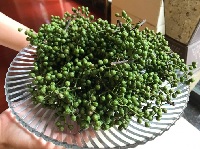0
















| Thumbs Up |
| Received: 83 Given: 0 |

More detailed results for the Fiji Islands’ yDNA and mtDNA can be found in “Melanesian and Asian Origins of Polynesians: mtDNA and Y Chromosome Gradients Across the Pacific”.
Different East Asian lineages are observed on different islands, that is, not all lineages of islanders, belonging to migrations, which accompanied Austronesians, could have survived on every island.
For example, ancient 4640-4240-year-old Xitoucun site in Fujian (close to the place of the onset of Austronesian migrations ) produced samples, belonging to yDNA NO-M214(xM175), yDNA O-M175*, yDNA K2 and yDNA F-M89, while yDNA O-M119 was observed in the Tanshishan site not far from the Xitoucun site. Moreover, one mtDNA A13 (sharing T3504C mutation with mtDNA D1 and mtDNA M4 (Onge-related) and having an affinity to Japan Jomon in “The deep population history of northern East Asia from the Late Pleistocene to the Holocene”) and autosomal DNA from Korea and Japan Jomon, belonging to yDNA O1b2-P49-related population, was observed in ancient Xitoucun in "Human population history at the crossroads of East and Southeast Asia since 11,000 years ago".
The mutation A7822G was observed in mtDNA B5b* in China (a Bianbian-related mtDNA lineage, which was obtained in exchange for mtDNA M80’D*), and 4527-4406-year-old mtDNA B5b2a2a2 was observed at the Xitoucun site. Judging by the IVPP materials, the population containing A7822G mutation and the population containing A7521G-RELATED G7521A! mutation of mtDNA M76 and mtDNA N9a10 most likely interacted in the past. mtDNA R+T16189C was also observed in ancient Xitoucun. Moreover, one Ban Chiang sample from Thailand clustered with ancient Xitoucun specimens (in in “The deep population history of northern East Asia from the Late Pleistocene to the Holocene”), which may point to the Xitoucun-related population’s participation in the migration of Cham Austronesians. mtDNA F(xF1) and mtDNA B4(xB4a, xB4b1) are observed in ancient Xitoucun, mtDNA F(xF1) and mtDNA B4b1 is observed in ancient Tanshishan
Dwellers of Indonesia’s East Nusa Tenggara, where speakers of Timor-Alor-Pantar Bunak language live (the Bunak language shares some vocabulary with Near Eastern languages in the reconstruction of Jager,2017), contain 32,3% of yDNA K-M9(xMS,xM214), which may also include yDNA K2a*. Dwellers of Indonesia’s East Nusa Tenggara include a case of yDNA C-M130*(xC1b,xM217).
Representatives of the Timor-Alor-Pantar Bunak people (below):
======================
Dwellers of Papua-New Guinea Highlands are dominated by local yDNA M and yDNA S. PNG Highlands yielded only one case of yDNA O-M119, but also PNG Highlands yielded one female mtDNA lineage, marked as “Others”. Papua-New Guinea Highlands are a homeland of bearers of the Ketengban language, and 100% of the Ketengban men belong to yDNA M, which shares Z30993 mutation with yDNA R1b-FGC36423, most likely due to the common descent from the yDNA K2b ancestor. The Ketengban language also shares some vocabulary with Near Eastern languages in the reconstruction of Jager,2017.
”The Ketengban men pray for the weather to clear” (on the picture below)

There are currently 1 users browsing this thread. (0 members and 1 guests)
Bookmarks